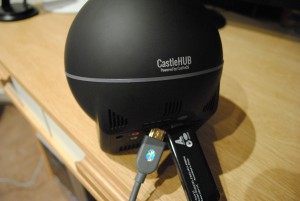Physical Design
The CastleHUB isn’t the best designed product I’ve used. The orb style shape means you can’t stack anything on top of the CastleHUB. Not that you’d want to put anything heavy on it. However, with the top of the CastleHUB being a circle, it might make it hard to find a place to hide the hub in a cupboard or elsewhere.
The big pain point I have with the physical design, is the USB port spacing. On the back of the CastleHUB there are 6 USB ports available (4 USB3 and 2 USB2). These should be designed for you to plugin your own home automation radios, and Kinects. With a USB Zwave Dongle plugged into the first USB3 port, it blocks the HDMI port of the CastleHUB. It also makes the adjacent USB port an extremely tight fit. If you have two USB radio dongles of the same size, you’ll need to plan carefully on which USB port you use.

The CastleHUB with a HDMI cable and Zwave Adapter
This is a clear indicator of where the software and hardware have been done by two separate companies. In this case, CastleOS has just re-badged a Zotac PC, but hasn’t considered that more USB port spacing might be needed for typically larger size USB devices used in Home Automation.
Powering Up
As I pointed out in my unboxing, unless you have a spare keyboard and monitor on hand, you’re going to need to plug the CastleHUB into your router via ethernet. Unlike virtually every other Hub/Device on the market with this requirement, there’s no ethernet cord included in the box.
CastleHUB Unboxing
See my Unboxing video of the CastleHUB Kickstarter.
Watch Now
I was able to download the CastleOS Android App on my phone, which detected the CastleHUB on my network. The quick start guide that ships with the CastleHUB mentions an iOS app as well, however there is no CastleOS App in the Apple Appstore. If you don’t have an Android phone, you’ll either need to login to your router to find out what the IP address of the CastleHUB is, or plug in a monitor and keyboard.
As soon as I plugged the CastleHUB into my power outlet, it booted up. The blue light on the Hub was on, so I knew the Hub was up. However, another clear separation of the software and hardware not talking to each other, is there’s no indication on the CastleHUB to let you know when CastleOS is up and running. On other Hubs, or devices which are designed to be “headless” (no monitor or keyboard required), there is usually some LED indicators so you can quickly look at the status of the device. Some examples include every router/modem on the market, and of course the Philips Hue Bridge.
Initial Setup
After waiting a minute or two (while I imagined what point in the Windows 10 boot process it was up to) my Android App connected to the CastleHUB. I logged in with the default username and password (admin and password1234). Watch out for the username input box on Android. By default it will capitalize your username to Admin, which won’t work.
Here’s something that’s not mentioned in the quick start guide, nor anywhere clearly for that matter. I only know because I found out the hard way testing CastleOS before my CastleHUB arrived. Don’t use the default admin account for anything. Don’t setup devices. Don’t set your network settings. The ONLY thing the admin account should be used for, is to create your own username and password. Infact, if you start changing settings under the admin account, you WILL cause issues. I know from experience.
After my initial login to CastleOS, I can see there’s a new version of CastleOS available. However, there is no button to invoke the update to download or install. I have to wait until CastleOS decides to install it. Very frustrating.
Crisis Hits
By default, the power button on the CastleHUB will place your CastleHUB to sleep. The blue light will start flashing. There is no way to safely cut power to the CastleHUB via the web interface. After setting up my initial events, I power down my CastleHUB the only way I can, pulling the power cord (I didn’t have access to a keyboard/monitor). After relocating the CastleHUB to its new home, I restore power to the CastleHUB, and attempt to log back into CastleOS.
Instead of the black and gloomy CastleOS login screen, I was presented with a blank white screen. I couldn’t access anything. I killed the power a few more times to try force CastleOS to start, but nothing would work. At this point I need to plugin my monitor and keyboard. The CastleHUB as a headless device has failed.
My attempts to access CastleOS on the device itself are fruitless. The white screen of death comes up when accessing localhost, and the Kinect Service Configurator complains it can’t connect.
I uninstalled CastleOS, and then read a note on the forum not to do that. Looks like others have had similar issues. Dammit! I had no choice. After uninstalling CastleOS, I read about the config files in the hidden folder C:\Program Data\CastleOS. I took a backup of these, and deleted the folder. After a re-install, I was back to square one. It turns out me killing power to the CastleHUB corrupted my configuration file.
This is another case-in-point where the hardware and software don’t work well together. Unless you attach a monitor and keyboard, you can’t safely turn off the CastleHUB. Sometimes, power might go out due to power failures. In this case, all those hours you’ve spent setting up CastleOS could be undone in seconds. Infact, only a couple of weeks ago this happened to someone else on the CastleOS forums. The current “fix” is to attach a UPS to the CastleHUB.
When I reported the issues to Chris at CastleOS, his customer service was excellent. Since my initial config corruption CastleOS now takes backups of the settings and stores them in C:\Program Data\CastleOS automatically. If you ever run into the white screen of death, then these should have you covered. However, for the time being a blackout could still take out your home automation, even when power returns to the CastleHUB.
It took a few weeks of back-and-forward with Chris at CastleOS to finally start getting my CastleHUB to be stable. I can’t tell you how many times I had to uninstall and re-install CastleOS. At one stage all the topics on the first page of the Bug Reports forum were from me.
Activating CastleOS
Another flaw that can be put down to the separate hardware and software vendors is the CastleOS license. This may be improved for purchases from the website directly, but for pre-orders via Kickstater, CastleOS sent your license code in a separate email. All the license information on the CastleHUB packaging means nothing. You need to request your CastleOS license from CastleOS to activate the product.
Entering my product key (which is HUGE) had the same reaction as enabling Hue. There was no visual feedback to say my key had been rejected or accepted. The settings page just reloads. I had to enter my license key a couple of times, before the settings page would say activated.
Compatible Devices
The Compatible Devices page on CastleOS is rather misleading. I first came across CastleOS because of their Kickstarter Campaign. Since then, the Supported Devices page doesn’t appear to have been updated. The Kinect for Xbox One (Kinect v2) is still listed as being compatible with CastleOS. It is not.
Sonos speakers are marked as compatible. However, you can’t control playback or change inputs. The only thing you can do with Sonos speakers is issue Text-to-Speech announcements. Until Sonos release their API (and CastleOS implements their media features, which are still “coming soon”), you won’t be able to do much with Sonos unless you run your own server and use Custom Scripting.
I’ve also got issues with my Aeotec Zwave Multisensors, which have only been supported by CastleOS since December 2015. Right now I can get motion working, but the other sensors (Temperature, Brightness, Humidity) won’t work in CastleOS. I was able to download and install a trial version of Homeseer, and confirmed that there’s no hardware issues with my setup. Its now up-to CastleOS to get that device supported.
Forced Automatic Updates
On at least two occasions, automatic updates have broken some part of my home automation. From a bug being introduced, to at one point the Kinect Service being completely uninstalled from my CastleHUB. Which means my voice control stops working, and I look like an idiot yelling at the CastleHUB in front of my girlfriend.
The worst part about these automatic updates is there’s no ability for you to disable them. Like the threat of a power failure crippling your installation of CastleOS, you now have the added threat of a buggy update being forced down your throat. With CastleOS trying to keep things out of the cloud as possible, it seems like a contradiction to have updates forced on for everyone.
Next Up
Stay tuned as I go through the initial setup of my CastleHUB, put voice control through some tests, and test out the scripting features of CastleOS. So be sure to follow me or subscribe on your favourite social media.
[facebook_follow_button href=”https://www.facebook.com/philhawthorne” layout=”button”]







